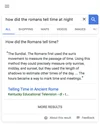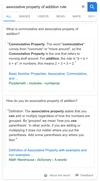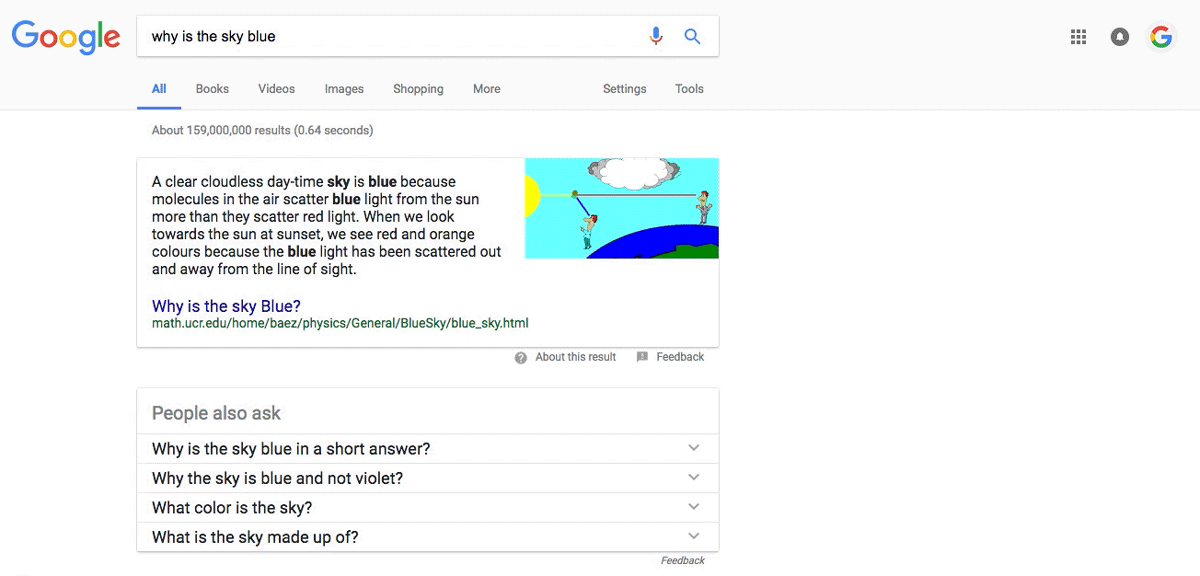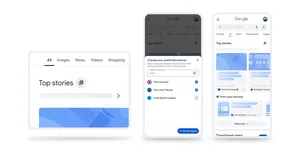A reintroduction to Google’s featured snippets
Sometimes when you do a search, you’ll find that there’s a descriptive box at the top of Google’s results. We call this a “featured snippet.” In this post—the first in a new series going behind-the-scenes on how Google Search works—we’ll explore when, where and why we provide featured snippets.
What is a featured snippet?
Let’s start with a look at a featured snippet, in this case, one that appears for a search on “Why is the sky blue?”
We call these featured snippets because unlike our regular web listings, the page’s description—what we call a “snippet”—comes first. With featured snippets, we reverse the usual format. We’re featuring the snippet, hence the “featured snippet” name. We also generate featured snippets in a different way from our regular snippets, so that they’re easier to read.
We display featured snippets in search when we believe this format will help people more easily discover what they’re seeking, both from the description and when they click on the link to read the page itself. It’s especially helpful for those on mobile or searching by voice.
Here are a few examples where featured snippets enhance the search experience by making it easier to access information from good sources, big and small:
Featured snippets aren’t just for written content. Our recently launched video featured snippets jump you directly to the right place in a video, such as for how to braid your own hair:

Featured snippets help with mobile and voice search
Mobile search traffic has surpassed desktop traffic worldwide. And with the growth in voice-activated digital assistants, more people are doing voice queries. In these cases, the traditional "10 blue links" format doesn't work as well, making featured snippets an especially useful format.Of course, we continue to show regular listings in response to searches along with featured snippets. That’s because featured snippets aren’t meant as a sole source of information. They’re part of an overall set of results we provide, giving people information from a wide range of sources.
People click on featured snippets to learn more
When we introduced featured snippets in January 2014, there were some concerns that they might cause publishers to lose traffic. What if someone learns all they need to know from the snippet and doesn’t visit the source site?It quickly became clear that featured snippets do indeed drive traffic. That’s why publishers share tips on how to increase the chances of becoming one, because they recognize being featured in this way is a traffic driver.
When it comes to spoken featured snippets, we cite the source page in the spoken result and provide a link to the page within the Google Home app, so people can click and learn more:

We recognize that featured snippets have to work in a way that helps support the sources that ultimately makes them possible. That’s why we always take publishers into account when we make updates to this feature.
Working to improve featured snippets
The vast majority of featured snippets work well, as we can tell from usage stats and from what our search quality raters report to us, people paid to evaluate the quality of our results. A third-party test last year by Stone Temple found a 97.4 percent accuracy rate for featured snippets and related formats like Knowledge Graph information.Because featured snippets are so useful, especially with mobile and voice-only searches, we’re working hard to smooth out bumps with them as they continue to grow and evolve.
Last year, we took deserved criticism for featured snippets that said things like “women are evil” or that former U.S. President Barack Obama was planning a coup. We failed in these cases because we didn’t weigh the authoritativeness of results strongly enough for such rare and fringe queries.
To improve, we launched an effort that included updates to our Search Quality Rater Guidelines to provide more detailed examples of low-quality webpages for raters to appropriately flag, which can include misleading information, unexpected offensive results, hoaxes and unsupported conspiracy theories. This work has helped our systems better identify when results are prone to low-quality content. If detected, we may opt not to show a featured snippet.
Even when a featured snippet has good content, we occasionally appear to goof because it might not seem the best response to a query. On the face of it, it might not appear to respond to a query at all.
For example, a search for “How did the Romans tell time at night” until recently suggested sundials, which would be useless in the dark:

While the example above might give you a chuckle, we take issues like this seriously, as we do with any problems reported to us or that we spot internally. We study them and use those learnings to make improvements for featured snippets overall. In this case, it led to us providing a better response: water clocks.
When near-matches can be helpful
Another improvement we’re considering is to better communicate when we give you a featured snippet that’s not exactly what you searched for but close enough that it helps you get to the information you seek.For example, the original “sundial” featured snippet above was actually a response for “How did Romans tell time.” We displayed this near-match then because we didn’t have enough confidence to show a featured snippet specifically about how Romans told time at night. We knew sundials were used by Romans to tell time generally, because so many pages discussed this. How they told time at night was less discussed, so we had less data to make a firm connection.
Showing a near-match may seem odd at first glance, but we know in such cases that people often explore the source of a featured snippet and discover what they’re looking for. In this case, the page that the featured snippet originally came from did explain that Romans used water clocks to tell time at night. We just didn't then have enough confidence then to display that information as a featured snippet.
We’re considering increasing the use of a format we currently employ only in some limited situations, to make it clearer when we serve a near-match. For example, we might display "How did Romans tell time?" above the featured snippet, as illustrated in the mockup below:

Our testing and experiments will guide what we ultimately do here. We might not expand use of the format, if our testing finds people often inherently understand a near-match is being presented without the need for an explicit label.
Improving results by showing more than one featured snippet
Sometimes, a single featured snippet isn’t right for every question. For example, “how to setup call forwarding” varies by carrier. That’s where a recent feature we launched lets you interactively select a featured snippet specific to your situation. In the example below, you can see how it allows people to quickly locate solutions from various providers:
Another format coming soon is designed to help people better locate information by showing more than one featured snippet that’s related to what they originally searched for:

Showing more than one featured snippet may also eventually help in cases where you can get contradictory information when asking about the same thing but in different ways.
For instance, people who search for “are reptiles good pets” should get the same featured snippet as “are reptiles bad pets” since they are seeking the same information: how do reptiles rate as pets? However, the featured snippets we serve contradict each other.

This happens because sometimes our systems favor content that’s strongly aligned with what was asked. A page arguing that reptiles are good pets seems the best match for people who search about them being good. Similarly, a page arguing that reptiles are bad pets seems the best match for people who search about them being bad. We’re exploring solutions to this challenge, including showing multiple responses.
"There are often legitimate diverse perspectives offered by publishers, and we want to provide users visibility and access into those perspectives from multiple sources,” Matthew Gray, the software engineer who leads the featured snippets team, told me.
Your feedback wanted
Featured snippets will never be absolutely perfect, just as search results overall will never be absolutely perfect. On a typical day, 15 percent of the queries we process have never been asked before. That’s just one of the challenges along with sifting through trillions of pages of information across the web to try and help people make sense of the world.Last year, we made it easier to send us feedback in cases where a featured snippet warrants review. Just use the “feedback” link at the bottom of a featured snippet box. Your feedback, along with our own internal testing and review, helps us keep improving the quality of featured snippets.

We'll explore more about how Google Search works in future posts in this series. In the meantime, you can learn more on our Inside Google Search and How Search Works sites and follow @searchliaison on Twitter for ongoing updates.







